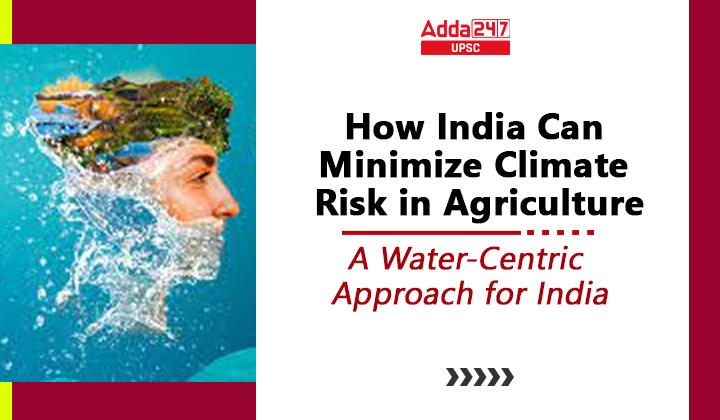Table of Contents
October 16 commemorates World Food Day, dedicated to reflecting on global food security. In the context of this year’s theme, “Water is Life, Water is Food,” it’s imperative to assess India’s progress in achieving food security and the utilization of its water resources in agriculture. Despite India’s remarkable strides in food production, challenges persist, particularly in addressing malnutrition and optimizing water use in agriculture. This article explores the need for a comprehensive strategy to minimize climate risks in agriculture, emphasizing the shift from water-intensive crops to those with lower water requirements.
Climate Risks in India
A recent climate risk report by the Cross Dependency Initiative (XDI) revealed that India is highly exposed to climate change vulnerabilities in terms of its infrastructure.
The report assessed 2,600 regions globally and ranked them based on their climate risks for the year 2050.
India, along with China and the United States, had 80% of the top 50 most at-risk states and provinces in 2050.
India’s Food Security Journey
Tracing India’s food security journey from the “ship to mouth” phase in the mid-1960s to becoming a net exporter of cereals, including rice, wheat, and corn, reveals a remarkable transformation. However, challenges remain in ensuring access to sufficient nutritious food for all. Examine the progress made and persistent challenges in achieving food security, considering factors like malnutrition and stunted growth among children.
Achievements and Challenges in Indian Agriculture
Food Security Milestones: A retrospective look at India’s journey from “ship to mouth” to becoming a net exporter of cereals and a powerhouse in milk, poultry, and fishery production
Unresolved Challenges: Despite progress, malnutrition and stunted growth statistics highlight the persistent challenges on the nutrition front.
World Food Day 2023, “Water is Life, Water is food
FAO’s Founding Ideals: Reflecting on the founding principles of the Food and Agriculture Organization and the current theme emphasizing the critical role of water in food production
India’s Progress: Evaluating India’s progress in achieving food security and the utilization of water resources in agriculture
Water Resources in Indian Agriculture: A Precarious Balance
India, home to almost 18% of the world’s population, possesses only 4% of global freshwater resources. As much as 78–90% of this water is utilized in agriculture. With a rising population and increasing urbanization, there’s an urgent need to optimize water usage. This section delves into the intricate balance between water availability and agricultural needs, emphasizing the impending water crisis and the need for a dual-focused strategy.
Crafting a Two-Pronged Water Strategy
Supply Side Measures: Augmenting water storage during the monsoon season, groundwater recharge through check dams, and watershed management
Demand Side Measures: Advocating for rational water allocation and efficient use across different crops
Financial Challenges in Implementing Water Strategies: Private Sector Investment Dilemma: Exploring the challenges in attracting private sector investments due to the perception of free water
Government Financial Constraints: Analyzing the financial constraints on the government amidst substantial subsidies in food and fertilizers
Shifting Focus to Water Productivity: Redefining Agricultural Productivity: Proposing a paradigm shift from land productivity to water productivity as a key metric
Identifying Inefficiencies: Drawing insights from studies on water productivity, emphasizing the need for efficient water use
Case Study: Punjab’s Water Inefficiency and Carbon Emissions: Land vs. Water Productivity: Unraveling the paradox where Punjab, with high land productivity in rice, demonstrates low irrigation water productivity
Environmental Impact: Analyzing high carbon emissions in paddy cultivation and the imperative for sustainable practices
Green Water Credits, Incentivizing Sustainable Farming
Rewarding Water-Efficient Crops: Proposing incentives for farmers to transition from water-intensive crops like paddy and sugarcane to millets, pulses, and oilseeds
Economic Shift: Discuss the potential redistribution of subsidies to support environmentally friendly and nutritious crop choices
Lessons from Punjab, Saving Groundwater from Overexploitation
Addressing the Water Crisis: Proposing measures to save Punjab from a looming water disaster with a focus on the overexploitation of groundwater
Financial Support: Considering financial support for farmers transitioning to water-efficient crops
International Context, Leveraging IPCC Data and IMO Reports
Climate Change Impacts: Utilizing data from the Intergovernmental Panel on Climate Change (IPCC) to underscore the threats climate change poses to agriculture
Global Water Perspectives: Examining reports from the International Maritime Organization (IMO) to draw parallels and collaborative solutions
A Call to Action, Towards a Sustainable Agricultural Paradigm
- Integrated Approach: Advocating for an integrated approach considering economic, environmental, and nutritional factors
- Collective Responsibility: Urging collaborative efforts within India and internationally to address water-related challenges in agriculture
Conclusion
As India stands at the nexus of agricultural prosperity and climate risk, it becomes imperative to adopt a water-centric approach. The proposed strategies, including encouraging sustainable agricultural practices and aligning agricultural policies with environmental and nutrition goals, can pave the way to a resilient and sustainable future. This World Food Day, let us not only celebrate achievements but also commit to transformative action for the betterment of both the nation and the planet.



 TSPSC Group 1 Question Paper 2024, Downl...
TSPSC Group 1 Question Paper 2024, Downl...
 TSPSC Group 1 Answer key 2024 Out, Downl...
TSPSC Group 1 Answer key 2024 Out, Downl...
 UPSC Prelims 2024 Question Paper, Downlo...
UPSC Prelims 2024 Question Paper, Downlo...
